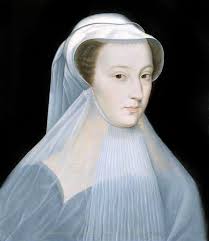Once upon a time, someone had the “good” idea to propose single-color meals. “All-white” and “all-pink” concoctions are among those identified in Donna Gabaccia's We Are What We Eat. They were part of an attempt to Americanize immigrants. Fortunately, good taste prevailed, and multi-hued ethnic cuisines came to be celebrated.
Imagine a monochrome, say all-white, meal. Symbolically, it might seem o.k. After all “white” carries positive associations: no impurities, no contaminants, no adulterations. By contrast, visually and gustatorily (if this is a word), an all-white plate would probably carry different associations: blandness, dullness, absence, and lack.
The color white thus reveals, surprisingly perhaps, conflicting associations. On one hand, white occasions positive reactions. It connotes cleanliness, purity, and virtue. Such associations have encouraged people to choose, as names, words meaning white, names like Blanche, Finnian, Gwen, Gavin, Genevieve, and Whitney. Wedding dresses, in most European cultures are white, a fad that took off after Queen Victoria broke with tradition and went with white for her ceremony.
On the other, mostly forgotten, hand, white has also carried negative connotations. Before Victoria and her white gown, there
was Mary Queen of Scots. She is depicted in a painting, wearing white to signal mourning. This was typical in her day. Fans of Clint Eastwood will recall Pale Rider. The film’s title alludes to “death,” the fourth
horseman of the Apocalypse, who rides a pale, i.e. white horse.
was Mary Queen of Scots. She is depicted in a painting, wearing white to signal mourning. This was typical in her day. Fans of Clint Eastwood will recall Pale Rider. The film’s title alludes to “death,” the fourth
horseman of the Apocalypse, who rides a pale, i.e. white horse.
Even when it comes to wedding gowns, white is not universal. Prior to Victoria, red was a
favorite. It still is in parts of Asia.
Even in the West, a small but real trend, reveals brides in dresses other than white. Red, pink, silver, green and blue are among the favorites.
favorite. It still is in parts of Asia.
Even in the West, a small but real trend, reveals brides in dresses other than white. Red, pink, silver, green and blue are among the favorites.
Perhaps the most famous negative treatment of white is found in Moby Dick. Ishmael, the narrator, undertakes a lengthy disquisition on white and its conflicting symbolic meanings. There are the positives: whiteness as a symbol of “gladness” of “joyfulness” of “innocence as with a bride,” or used as a pledge of honor (the Amerindians’“white belt of wampum”). There is also, this was considered by some to be a positive, the “white man” assuming ‘ideal mastership over every dusky tribe.” (Melville leaves unanswered why Europeans, who are not really white--just holding a sheet of paper next to my skin indicates the gap--nonetheless refer to themselves as white.)
Ishmael then highlights some negatives. As regards Moby Dick, “it was the whiteness of the whale that above all things” proved appalling. There is an “elusive something in the innermost idea of this hue, which strikes more of panic to the soul than that redness which affrights in blood.” Nature herself, in her “malicious” agencies, enlists, as in snow squalls, the forces of whiteness. Shrouds, paleness, ghosts make it hard to disentangle whiteness from death.
The all-white meal stirs up such negative associations. Life is colorful. The plants and animals that can grace grace our tables, are colorful. Red, as in blood, is a hue of life. Green, yellow, red, and orange, are the tints of plants that serve as food. Even white has its place, as with potatoes, rice and turnips.
The main problem with all-pink, or all-white, meals is not the color itself. It’s the “all.” Life is mixture, mingling, combinations, amalgamations, as with the multi-hued amalgamation of foodstuffs. This variegated palate has not ranked high with philosophers. Preferring rational purity, they have looked down on varieties, mixtures, blends. For them, unity and purity rank high. Mixtures and blendings are relegated to an inferior status and denigrated via terms like “mongrels,” ”’adulterations,” “impurities.”
The draw of purity and unity, along with the fear of mixture, runs deep in the human psyche. One too often unchallenged philosophical presupposition: the notion that unity/purity is both primal and to be prioritized over plurality/mixture. The Tower of Babel story is typical in this regard.
Maize, for example, is a wonder plant. Still, eaten alone it is disastrous for health. As native Americans realized, it has to be complemented with other foodstuffs, typically beans and squash. Corn-squash-beans; meat-vegetables-fruit. Multiplicity is our starting point. It does not represent some fall away from initial unity. Getting the right blends and mixes is the challenge. A meal that is all one color favors abstract philosophical concepts over life-enhancing practices. For healthy, not to mention aesthetically pleasing foods, go multicolored.








No comments:
Post a Comment